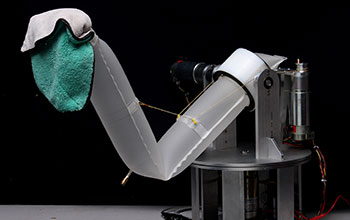Multimedia Gallery
Inflatable robotic arm inspires Disney character
A soft inflatable robot arm developed at Carnegie Mellon University's Robotics Institute. The inflatable arm has no rigid components in its structure and derives strength from pressurized air. The arm is actuated using cables, motors and pneumatics.
More about this image
The character "Baymax" in the Walt Disney animated feature film "Big Hero 6" was inspired by an inflatable robotic arm and hand developed at Carnegie Mellon University's (CMU) Robotics Institute. The fictional Disney robot is balloon-like and reflective of soft robotics, a growing field of research at CMU.
"The movie is a tremendous win for soft robotics," said Chris Atkeson, a robotics professor at CMU, in whose lab the inflatable arm robot was developed by Siddharth Sanan during his Ph.D. thesis research.
Atkeson says mobile robots made from soft materials like fabric, balloons and light plastics have advantages over robots made from metal, including lighter weight, lower cost and better safety when operating near people. Some of these robots may be worn while others may be disposable.
In general, when the public thinks of robots, they think of them as being metal, like industrial robots used in car assembly or "Wall-E," a popular robot from science fiction. In the new Disney film, "Baymax" is a gentle robot designed to care for humans but is later transformed into a warrior who joins a band of high-tech heroes.
"I think this movie will be inspirational for a lot of people," Atkeson added.
Atkeson's lab did not invent the inflatable arm--it came out of a National Science Foundation-sponsored Quality of Life Technology Center project, which adapts robotic technology to meet the needs of the elderly and people with disabilities--rather, they sought ways to make it practical. In particular, they sought to learn whether an arm of balloons could do work that required a high degree of safety; for example, giving a patient a sponge bath or feeding them.
Sanan, who today is a postdoctoral researcher working on soft, wearable robotics at Harvard University, worked on the project for years and used items like inflatable pool toys and stand-up dolls for ideas on how to build components of an inflatable, functional robot using tools like heat sealers and heat guns.
Using cables to actuate the limbs of his robot and hands that are pneumatically controlled, Sanan successfully made the inflatable arm rub a washcloth against his body and maneuver a spoon into his mouth. He and Atkeson subsequently worked with firms such as iRobot and OtherLab that are developing soft robots for the marketplace.
Inflatable robots are a nice fit in the health care industry because the soft materials they are made from are less likely to harm patients. And, says Sanan, inflatable robots are portable, and could be carried in a backpack or launched into space as a small package.
To learn more, see the CMU news story Carnegie Mellon's inflatable robotic arm inspires design of Disney's latest character. (Date image taken: 2011-2012; date originally posted to NSF Multimedia Gallery: Aug. 2016)
Credit: Siddharth Sanan, Carnegie Mellon University
See other images like this on your iPhone or iPad download NSF Science Zone on the Apple App Store.
Images and other media in the National Science Foundation Multimedia Gallery are available for use in print and electronic material by NSF employees, members of the media, university staff, teachers and the general public. All media in the gallery are intended for personal, educational and nonprofit/non-commercial use only.
Images credited to the National Science Foundation, a federal agency, are in the public domain. The images were created by employees of the United States Government as part of their official duties or prepared by contractors as "works for hire" for NSF. You may freely use NSF-credited images and, at your discretion, credit NSF with a "Courtesy: National Science Foundation" notation.
Additional information about general usage can be found in Conditions.
Also Available:
Download the high-resolution JPG version of the image. (2.4 MB)
Use your mouse to right-click (Mac users may need to Ctrl-click) the link above and choose the option that will save the file or target to your computer.

